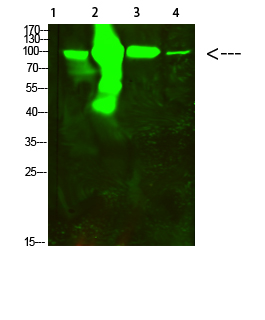ACO2 Polyclonal Antibody
- Catalog No.:YT6104
- Applications:WB;ELISA
- Reactivity:Human;Mouse;Rat;Canine
- Target:
- ACO2
- Fields:
- >>Citrate cycle (TCA cycle);>>Glyoxylate and dicarboxylate metabolism;>>Metabolic pathways;>>Carbon metabolism;>>2-Oxocarboxylic acid metabolism;>>Biosynthesis of amino acids
- Gene Name:
- ACO2
- Protein Name:
- ACO2
- Human Gene Id:
- 50
- Human Swiss Prot No:
- Q99798
- Mouse Gene Id:
- 11429
- Mouse Swiss Prot No:
- Q99KI0
- Immunogen:
- Synthesized peptide derived from human ACO2. at AA range: 421-470
- Specificity:
- ACO2 Polyclonal Antibody detects endogenous levels of ACO2
- Formulation:
- Liquid in PBS containing 50% glycerol, 0.5% BSA and 0.02% sodium azide.
- Source:
- Polyclonal, Rabbit,IgG
- Dilution:
- WB 1:500 - 1:2000. ELISA: 1:5000.Not yet tested in other applications.
- Purification:
- The antibody was affinity-purified from rabbit antiserum by affinity-chromatography using epitope-specific immunogen.
- Concentration:
- 1 mg/ml
- Storage Stability:
- -15°C to -25°C/1 year(Do not lower than -25°C)
- Other Name:
- Aconitate hydratase, mitochondrial (Aconitase) (EC 4.2.1.3) (Citrate hydro-lyase)
- Observed Band(KD):
- 90kD
- Background:
- The protein encoded by this gene belongs to the aconitase/IPM isomerase family. It is an enzyme that catalyzes the interconversion of citrate to isocitrate via cis-aconitate in the second step of the TCA cycle. This protein is encoded in the nucleus and functions in the mitochondrion. It was found to be one of the mitochondrial matrix proteins that are preferentially degraded by the serine protease 15(PRSS15), also known as Lon protease, after oxidative modification. [provided by RefSeq, Jul 2008],
- Function:
- catalytic activity:Citrate = isocitrate.,cofactor:Binds 1 4Fe-4S cluster per subunit. Binding of a 3Fe-4S cluster leads to an inactive enzyme.,online information:Aconitase entry,pathway:Carbohydrate metabolism; tricarboxylic acid cycle.,similarity:Belongs to the aconitase/IPM isomerase family.,subunit:Monomer.,
- Subcellular Location:
- Mitochondrion .
- Expression:
- Brain,Cajal-Retzius cell,Fetal brain cortex,Skeletal muscle,Uterus,
Epigallocatechin‐3‐gallate activates the AMP‐activated protein kinase signaling pathway to reduce lipid accumulation in canine hepatocytes. JOURNAL OF CELLULAR PHYSIOLOGY J Cell Physiol. 2021 Jan;236(1):405-416 WB Canine 1:500 Hepatocytes
- June 19-2018
- WESTERN IMMUNOBLOTTING PROTOCOL
- June 19-2018
- IMMUNOHISTOCHEMISTRY-PARAFFIN PROTOCOL
- June 19-2018
- IMMUNOFLUORESCENCE PROTOCOL
- September 08-2020
- FLOW-CYTOMEYRT-PROTOCOL
- May 20-2022
- Cell-Based ELISA│解您多样本WB检测之困扰
- July 13-2018
- CELL-BASED-ELISA-PROTOCOL-FOR-ACETYL-PROTEIN
- July 13-2018
- CELL-BASED-ELISA-PROTOCOL-FOR-PHOSPHO-PROTEIN
- July 13-2018
- Antibody-FAQs
- Products Images
.jpg)
- Ding, Hongyan, et al. "Epigallocatechin‐3‐gallate activates the AMP‐activated protein kinase signaling pathway to reduce lipid accumulation in canine hepatocytes." Journal of Cellular Physiology 236.1 (2021): 405-416.

- Western Blot analysis of 1,mouse-kidney 2,mouse-heart 3,3T3 4,Hela cells using primary antibody diluted at 1:500(4°C overnight). Secondary antibody:Goat Anti-rabbit IgG IRDye 800( diluted at 1:5000, 25°C, 1 hour)



